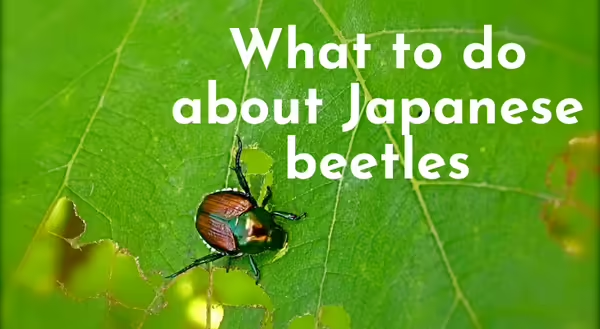
They’re back! After hitching their initial ride on imported ornamental plants in 1916, Japanese beetles decided North America isn’t such a bad place to live and have made a presence year after year since. Today, these pests can be a serious nuisance to gardeners and farmers throughout North America feeding on over 300 different species of trees, shrubs, and non-woody plants.
Adults first emerge around the end of June to early July hungry and ready to eat; some of their favorite plants include Japanese maple, rose-of sharon, roses, grape, cherry, and more. Individual beetles do not cause severe damage; when there are a group of beetles feeding in one area, the damage becomes more severe, and unfortunately, we often see Japanese beetles in groups. Feeding begins at the top of the plant, working downward; with adults chewing out tissue between the veins giving a lacelike appearance.
We can all probably spot damage done by adult beetles; however, damage done by Japanese beetle grubs can be just as much of an issue; grubs chew off grass roots which reduces the ability of the grass to take up water especially during the hot, dry summer weather resulting in large patches of dead grass. Japanese beetles overwinter in the grub stage; as soil temperatures warm to above 50°F in the spring, the grubs begin to move up into the root zone to feed.
There are many different options for managing Japanese beetles.
- Start by selecting plant species that are less desirable by Japanese beetles. Some of these plants include begonia, holly, dogwood, forsythia, columbine, impatiens, lilacs, hosta, and violets.
- Soil insecticides can be used to control grubs in the soil; however, Japanese beetles can fly long distances to find your lawn making these not entirely effective. Proper application time is also very important when it comes to soil insecticides.
- Removing beetles by hand can provide adequate protection when beetle numbers are low. The presence of beetles on a plant attracts more beetles, so remove beetles before too many congregate. The easiest way to remove beetles is to shake them off in the morning when they are sluggish. Beetles can be killed by putting them into a bucket of soapy water.
- Use cheesecloth or other fine netted material to protect high valued plants such as roses.
- Japanese beetle traps often attract more beetles than they can trap. Also, plants along the path to the traps are likely to suffer. These traps are not recommended for managing populations of Japanese beetles.
- Many insecticides are labeled for use against adult Japanese beetles. Insecticides are a more practical option for use in large scale settings such as production fields. For those seeking a natural option, Neem oil can provide a 3 to 4-day deterrence. If the chemical option is chosen, be sure to thoroughly treat foliage and flowers. One should always read and follow the label. Insecticides often control many insects including bees; it is important to weigh options when deciding on control tactics.
- Products such as insecticidal soaps, hot pepper, companion planting, or orange peels are generally ineffective.
Good Growing Fact: There is a concern that smashing Japanese beetles will release pheromones which will attract more beetles. Pheromones are used to attract beetles for mating; however, once the beetles have mated, they will no longer produce the pheromones, so it is okay to smash the beetles.